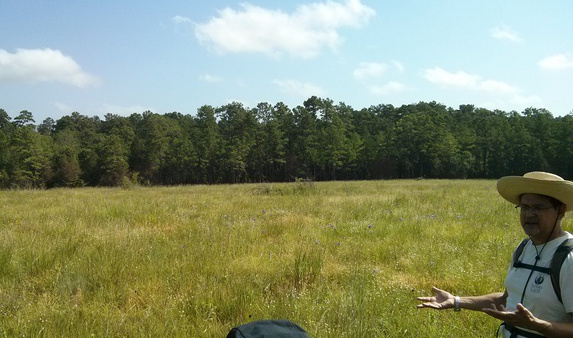For three years the Houston Sierra Club has assisted the U.S. Forest Service (FS) in restoration of blackland prairies in Sam Houston National Forest (SHNF). Scattered over the western and central part of SHNF are small (approximately 2-20 acre) natural prairies that are created from the Fleming geological formation. These native grasslands are commonly called “blackland prairies” due to the dark soils that they have, with high shrink-swell characteristics (cracks in and movement of the soil), and due to their marine origin which gives them a high calcium or calcareous content.
The Sierra Club has been interested in these prairies since the 1970s but it was only in the late 1990s and 2000s that the Club began lobbying the FS for better management of these areas. Important management elements for blackland prairies include removal of cattle from these areas due to their highly erodable soils, removal or cutting of woody plants, and burning these areas regularly, every 1 to 2 years, to reduce existing woody plant growth or an increase in woody plants.
The Sierra Club, with a very small cadre of volunteers, has worked on two blackland prairies to date. Both are located in the far northwestern part of SHNF in Compartment 1, Stand 7, and in Compartment 2, Stand 2. A compartment, in FS lingo, is usually about 800-1,500 acres in size and is used as an easily delineated area with boundaries with which to manage the ecosystems that lie within it. A stand is a forest, or in this case, prairie, that has similar characteristics so that management is easier to do.
Most of Compartment 1, which is 1,233 acres, and Compartment 2, which is 758 acres, contain the upland pine-hardwood ecosystem that covers much of SHNF. There are areas in Compartments 1 and 2 that have significant populations of Post Oak and that may at one time have been part of the Post Oak Ecoregion that exists just west of SHNF, and there are a few blackland prairies.
There are many fascinating and beautiful grasses and herbaceous plants (wildflowers) that grow on these blackland prairies including bluebells, Rattlesnake Master, Little Bluestem, Knotroot Bristle Grass, Snow-on-the-Prairie, bluets, Basket Flower, Yellow Powder Puff, Blue Sage, Purple Prairie Clover, Purple Coneflower, Black-eyed Susan, Texas Vervain, Silver Bluestem, White Heliotrope, and many more. In the right season, blackland prairies are covered with beautiful dots of yellow, white, purple, blue, and many other colors. Blackland prairies, from March to November, have different waves of plants bloom throughout the year.
The Sierra Club has received permission from the FS to cut down woody plants on the prairies in Compartments 1 and 2. The Club cleared one portion of Compartment 2, Stand 2, that was becoming overgrown with woody plants and now it is full of blooming wildflowers and grasses. The Sierra Club is now focused on Compartment 1, Stand 2, and has removed many of the woody plants from that blackland prairie and hopes to finish the job by the end of the year.
The Club cuts down small Eastern Red Cedar, Water Oak, White Ash, Yaupon Holly, Coral Berry, greenbriar, dewberry and blackberry, native privet, Gum Bumelia, and other woody plants so that native grasses and wildflowers will have more shade and less competition for nutrients and water.
On Saturday, August 13, 2016, the Houston Sierra Club will have an outing to SHNF where we will visit several of these blackland prairies to see what is blooming or is about to bloom. Please check the Houston Sierra Club Outings Meet-up site for more details if you want to see and learn about these blackland prairies on August 13th.
Brandt Mannchen
June 24, 2016